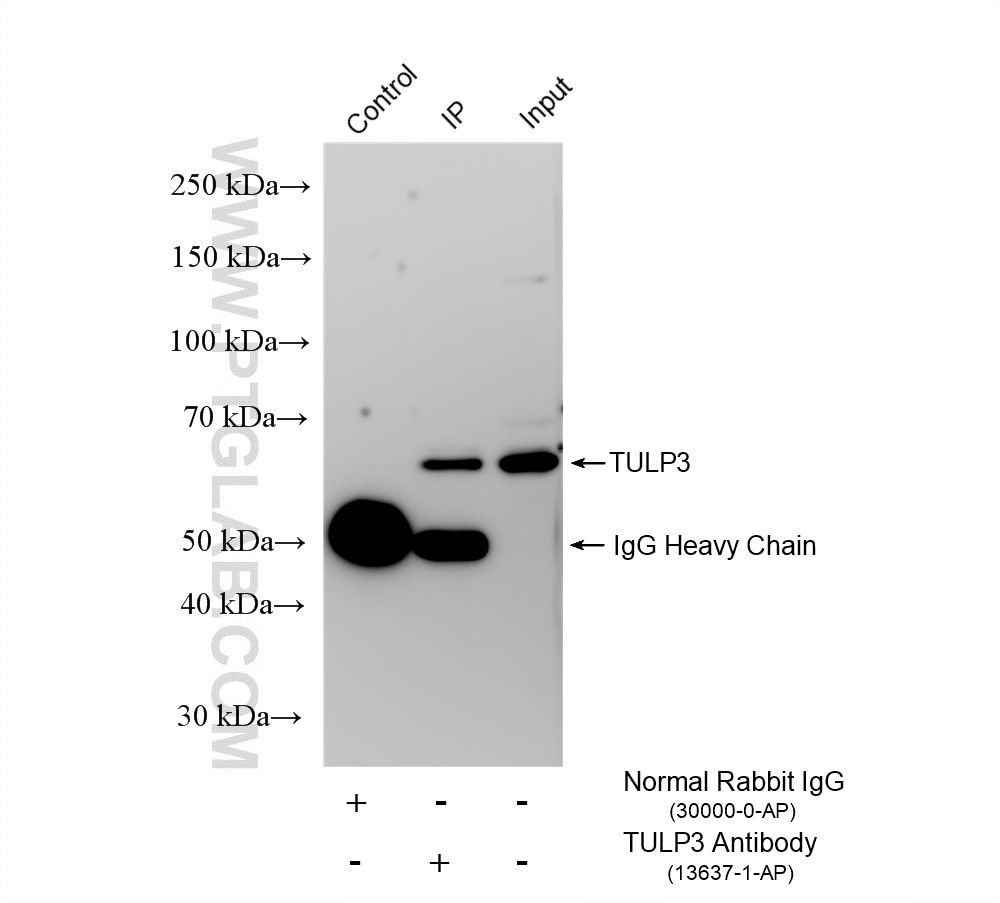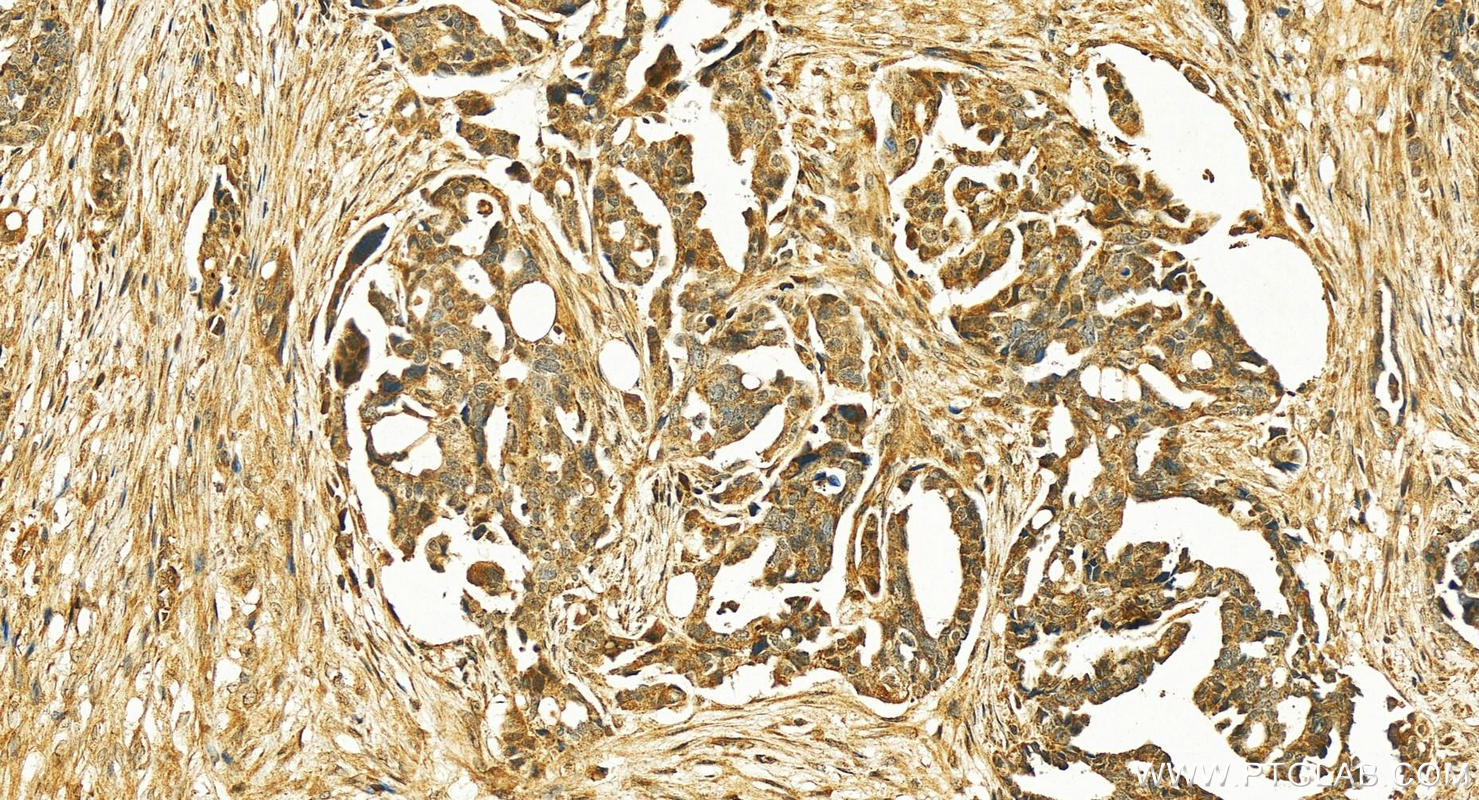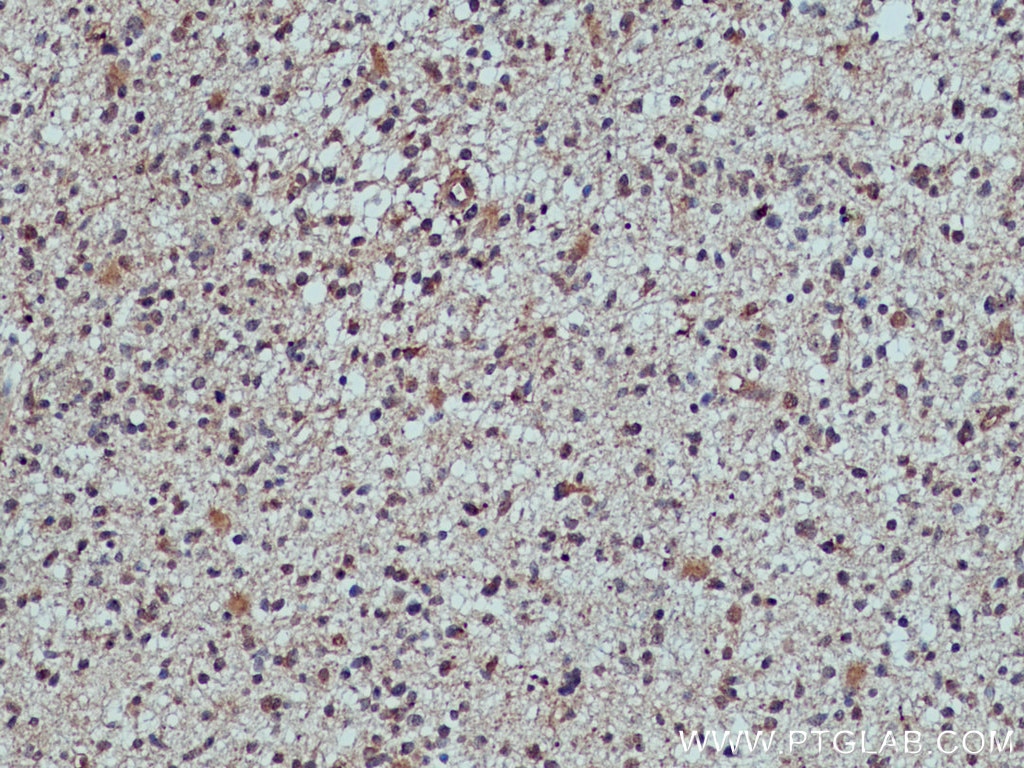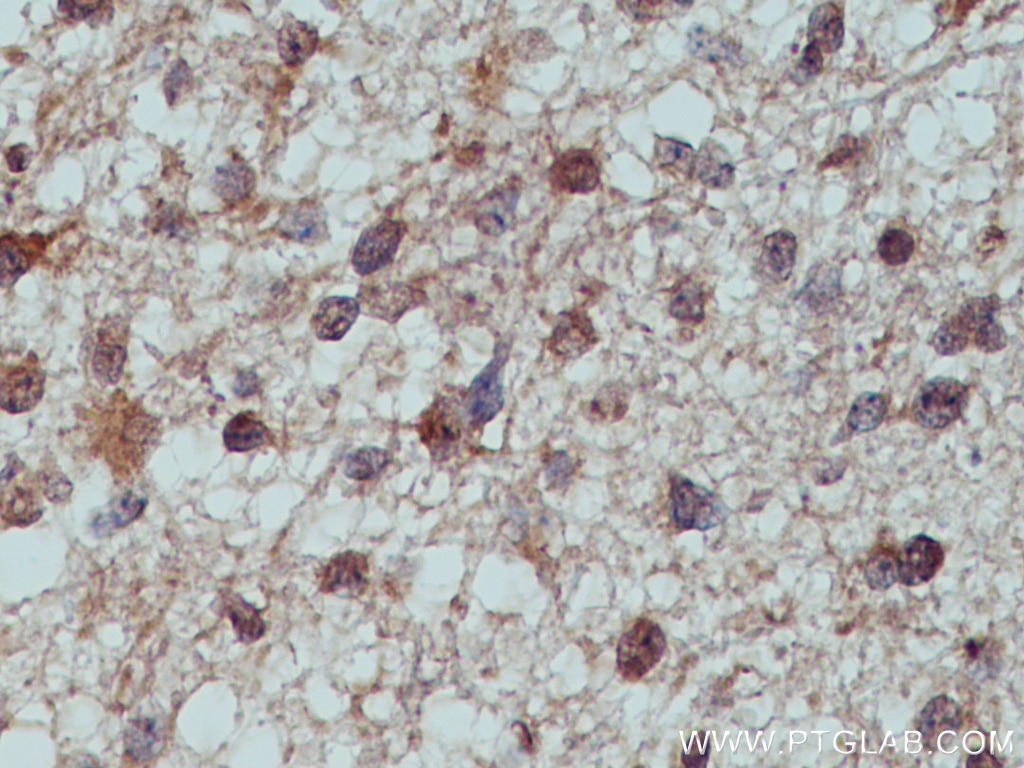- Featured Product
- KD/KO Validated
TULP3 Polyklonaler Antikörper
TULP3 Polyklonal Antikörper für WB, IHC, IP, ELISA
Wirt / Isotyp
Kaninchen / IgG
Getestete Reaktivität
human, Maus, Ratte
Anwendung
WB, IHC, IF, IP, CoIP, ELISA
Konjugation
Unkonjugiert
Kat-Nr. : 13637-1-AP
Synonyme
Geprüfte Anwendungen
| Erfolgreiche Detektion in WB | HEK-293-Zellen, HeLa-Zellen, SH-SY5Y-Zellen |
| Erfolgreiche IP | SH-SY5Y-Zellen |
| Erfolgreiche Detektion in IHC | human ovary cancer tissue, humanes Gliomgewebe Hinweis: Antigendemaskierung mit TE-Puffer pH 9,0 empfohlen. (*) Wahlweise kann die Antigendemaskierung auch mit Citratpuffer pH 6,0 erfolgen. |
Empfohlene Verdünnung
| Anwendung | Verdünnung |
|---|---|
| Western Blot (WB) | WB : 1:1000-1:8000 |
| Immunpräzipitation (IP) | IP : 0.5-4.0 ug for 1.0-3.0 mg of total protein lysate |
| Immunhistochemie (IHC) | IHC : 1:50-1:500 |
| It is recommended that this reagent should be titrated in each testing system to obtain optimal results. | |
| Sample-dependent, check data in validation data gallery | |
Veröffentlichte Anwendungen
| KD/KO | See 4 publications below |
| WB | See 9 publications below |
| IHC | See 1 publications below |
| IF | See 9 publications below |
| CoIP | See 1 publications below |
Produktinformation
13637-1-AP bindet in WB, IHC, IF, IP, CoIP, ELISA TULP3 und zeigt Reaktivität mit human, Maus, Ratten
| Getestete Reaktivität | human, Maus, Ratte |
| In Publikationen genannte Reaktivität | human, Maus |
| Wirt / Isotyp | Kaninchen / IgG |
| Klonalität | Polyklonal |
| Typ | Antikörper |
| Immunogen | TULP3 fusion protein Ag4570 |
| Vollständiger Name | tubby like protein 3 |
| Berechnetes Molekulargewicht | 442 aa, 50 kDa |
| Beobachtetes Molekulargewicht | 60 kDa |
| GenBank-Zugangsnummer | BC032587 |
| Gene symbol | TULP3 |
| Gene ID (NCBI) | 7289 |
| Konjugation | Unkonjugiert |
| Form | Liquid |
| Reinigungsmethode | Antigen-Affinitätsreinigung |
| Lagerungspuffer | PBS with 0.02% sodium azide and 50% glycerol |
| Lagerungsbedingungen | Bei -20°C lagern. Nach dem Versand ein Jahr lang stabil Aliquotieren ist bei -20oC Lagerung nicht notwendig. 20ul Größen enthalten 0,1% BSA. |
Hintergrundinformationen
The tubby-like protein 3 (TULP3) has been identified as a member of tubby and tubby-like proteins (TULPs) that plays an important role in maintenance and function of neuronal cells during development and post-differentiation. Tulp3 gene is essential for embryonic development in mice. Recently TULP3 has been reported to bind to the IFT (intraflagellar transport)-A complex and promote trafficking of G protein-coupled receptors into primary cilia, which is implicated in regulating neuronal function.
Protokolle
| PRODUKTSPEZIFISCHE PROTOKOLLE | |
|---|---|
| WB protocol for TULP3 antibody 13637-1-AP | Protokoll herunterladen |
| IHC protocol for TULP3 antibody 13637-1-AP | Protokoll herunterladenl |
| IP protocol for TULP3 antibody 13637-1-AP | Protokoll herunterladen |
| STANDARD-PROTOKOLLE | |
|---|---|
| Klicken Sie hier, um unsere Standardprotokolle anzuzeigen |
Publikationen
| Species | Application | Title |
|---|---|---|
Sci Adv Ciliopathy protein HYLS1 coordinates the biogenesis and signaling of primary cilia by activating the ciliary lipid kinase PIPKIγ. | ||
PLoS Genet Zfp423 Regulates Sonic Hedgehog Signaling via Primary Cilium Function.
| ||
J Neurosci Comparison of ciliary targeting of two rhodopsin-like GPCRs: role of C-terminal localization sequences in relation to cilium type.
| ||
J Biol Chem Deletion of the phosphatase INPP5E in the murine retina impairs photoreceptor axoneme formation and prevents disc morphogenesis. |
Rezensionen
The reviews below have been submitted by verified Proteintech customers who received an incentive for providing their feedback.
FH Evan (Verified Customer) (09-30-2019) | One of the worst antibodies I have ever used. I do not believe this antibody accurately detects Tulp3 by western blotting at all. The amount of non-specific bands at all sizes is so bad this antibody is pretty much only good for a protein stain. I have wasted weeks trying to get this antibody to work to no avail. Avoid this product for western blotting at all costs.
|
FH Francesc (Verified Customer) (09-19-2018) | We previously described that TULP3 (a PIP2-binding protein) accumulates in INPP5E-KO cilia, which also accumulate PIP2 (Garcia-Gonzalo et al. 2015 Dev Cell 34:400-409). We have successfully confirmed those results using Proteintech's anti-TULP3 antibody (13637-1-AP) in both mouse embryonic fibroblasts (MEFs, see my previous review) and in hTERT-RPE1 cells (here). This TULP3 antibody works beautifully, especially in human cells (it also works well in MEFs, but ciliary signal is less intense and lower dilution is needed). As far as I know, this is the best commercial anti-TULP3 available.
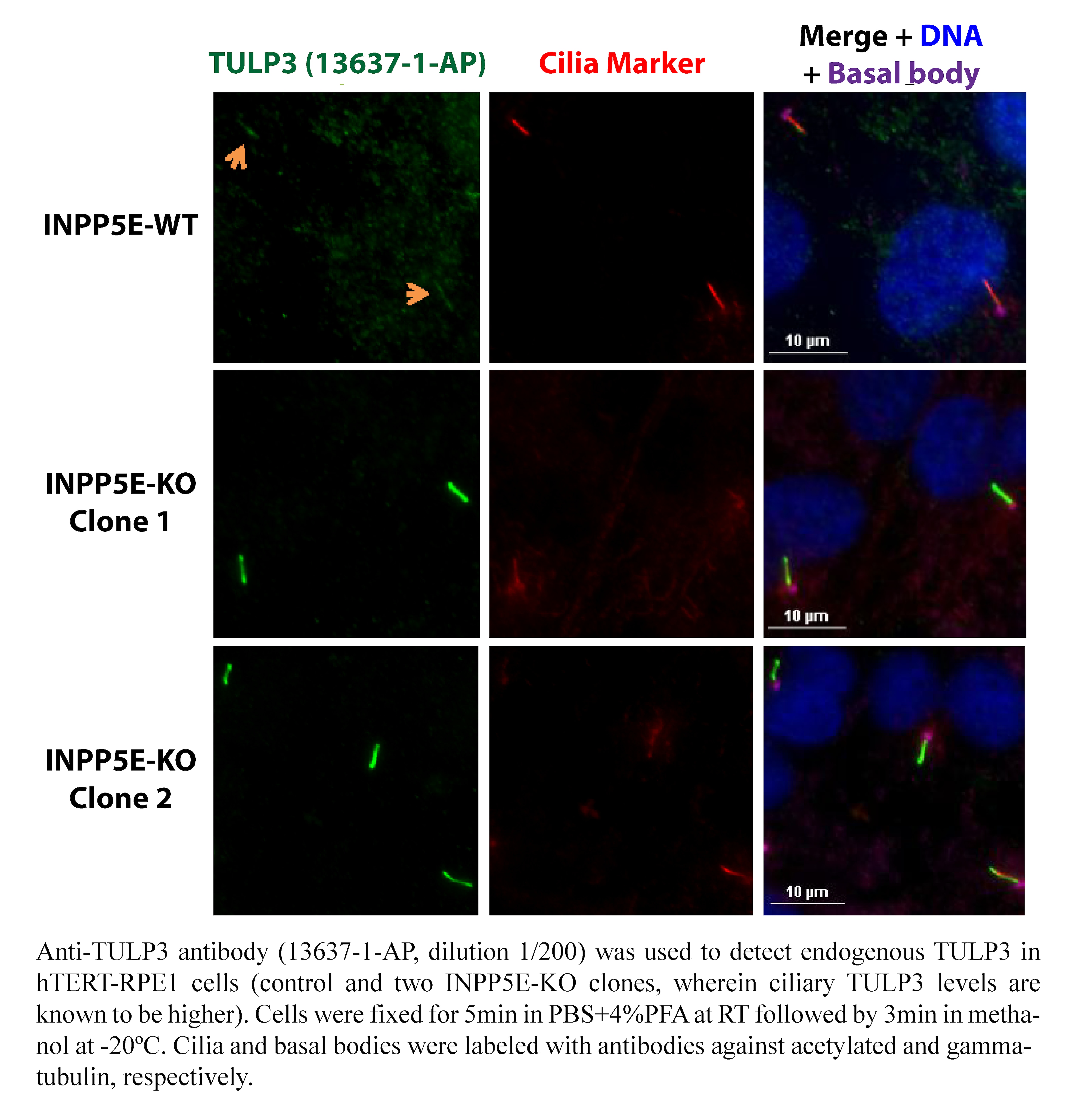 |


